The wandering field correspondent, MacDuff, somehow found his way into the competition at Foxburg and filed the following report.
August 2022
By MacDuff
There are many hickory golf tournaments, but few are hosted with such passion and emotion as the Foxburg Hickory Championship. It is Tom Johnson’s passion that drives this sweetly elegant hickory golf event, a gutty golf event, over the nation’s ancient Foxburg Country Club (1887).
This mild, self-effacing Ohioan and his helpmeet and equal partner in every important way, Karen, have annually for the past 14 years hosted this event which doubles as a fundraiser for the ancient club, indeed, the gutty golf event is its chief fundraiser of the year, operating as it does on a truly modest budget of some $50,000 or so. There is a project afoot to improve its prospects, but more on this in a moment.
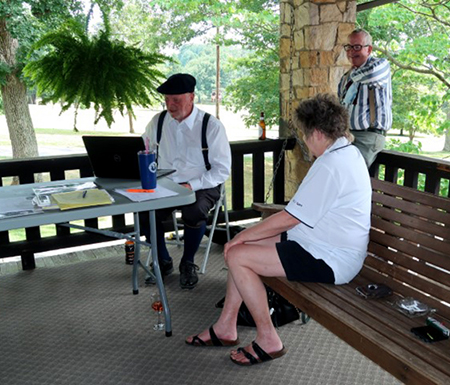
The 2022 FHC was, with 40 players, the largest field yet, a number viewed with anxiety by the logistics-minded Karen, but with dogged acceptance by Tom who wished to turn no one away. (Take note FHC fans, the field may be limited in the future.) The players traveled from 16 states, as far as Washington and Florida. Two Canadians might have come had it not been for some last minute conflicts.
“It is a family,” Tom told the field just before the first round got underway. “Every one of you is part of this Foxburg family, my family.” Tom gets emotional about these things and at times his deep voice stumbled, choked with feeling about the willingness of these players to travel, to play gutty golf here in Western Pennsylvania and to support a historic golf club that has few other voices or the ear of a national media tuned to more glamorous or controversial golfing matters.
What it does have is the wholehearted support of men such as Tom and of another Foxburg champion, John Crow Miller, of Dallas, Texas, who has authored a monograph on the club titled: Foxburg Country Club: The Stonehenge of American Golf.
Its 11 pages are a lovely testament to the history of the club, its signature stone tee boxes, to those who have labored over the years to maintain it and who now work so hard to preserve it. There is no doubt it is a gem of golf history, a 9-hole gem in the crown of American golf.
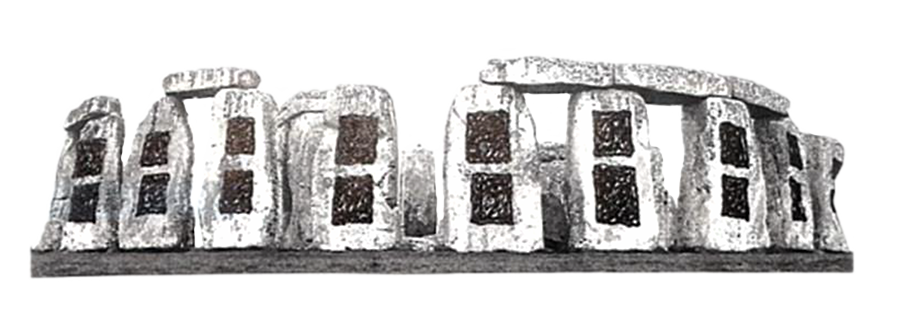
The cover image on Miller’s monograph is a Stonehenge-like arrangement of Foxburg’s iconic granite stone water/sand boxes used for making sand tees in that long ago era. As with the ancient English monument of that name, the makers of the Foxburg tee stones are unknown, but the fact they still exist is a cause for some wonder, at least among golf historians. “History is one thing, but living history is quite another,” Miller writes. (Some copies of the book are yet available, by writing or calling the club itself or by emailing Tom Johnson at foxburghickory@aol.com.)
Jeff Texter, the former superintendent of the club, as his father before him, said the boxes were once piled, forgotten, behind the club’s maintenance barn. When it was thought to move them out by tee areas on the course, they were used as flower boxes and at times bore the indignity of discarded trash.
Once Tom Johnson saw them, however, all that changed. He knew their worth and significance and convinced Texter to work with a friend who had a backhoe – each box must weigh some 400 pounds – to place them in the proper places and to be recalled, at least once a year, to their original duty.
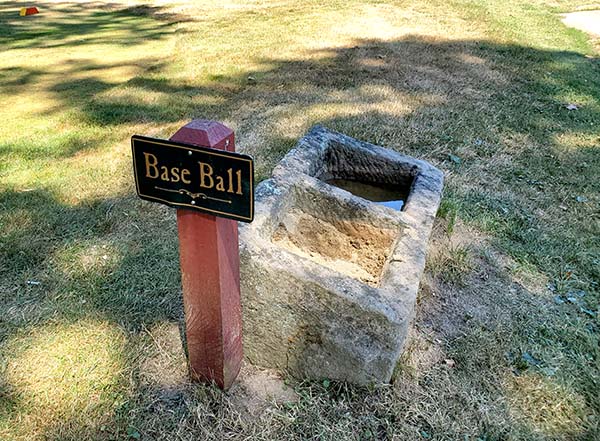
The 40 players of the 2022 FHC knew what to do. By the end of the second day’s play, much of the sand in the boxes had been relocated, pinch by pinch, to the teeing area, little splashes where play clubs and irons had struck off the replica gutta percha balls with a resounding “click,” a sound surely as historic as the boxes themselves. Harry Vardon once wrote that, for him, the sound of a gutta ball’s “click” off the club face was the sound of golf, one that was lost – until these days! – when the rubber core ball emerged around the early 1900s.
Foxburg’s hickory championship hosts several divisions for players who mostly negotiate Foxburg’s hard fairways and challenging greens with pre-1900 clubs, or replica wooden clubs of that era.
Speaking of replica wooden clubs, Elmer Nahum of Sewickley, Pa., played with a set of long nose wooden clubs that he had made from hand. He uses no electric tools, but only blades, hammers and saws such as were available to those long ago club makers. His clubs are absolute works of art. He wanted to play them, to see which he liked. Nahum has a magnificent full-bodied roundhouse of swing that brings that wonderful club upon the ball with a studied violence. By the end of his round he was convinced that his baffing spoon was his go-to weapon. He will build a playset for himself based on that club’s characteristics. Nahum has gathered all his experience in club crafting into a handsome book titled, Practical Clubmaking, the nearest thing to a bible on this meticulous and somewhat historic art form. He might not call it an art form, but after seeing his clubs, I most certainly will take that liberty.
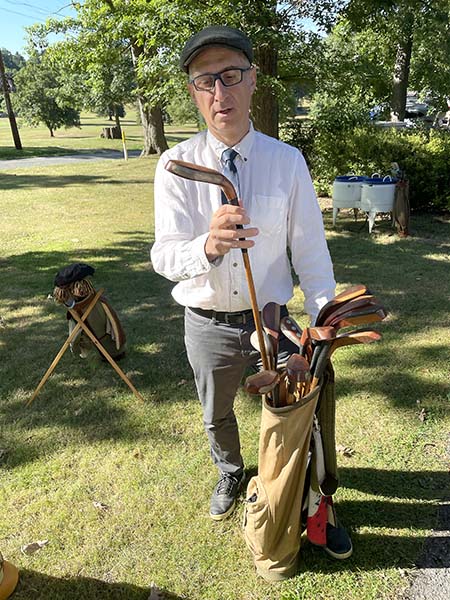
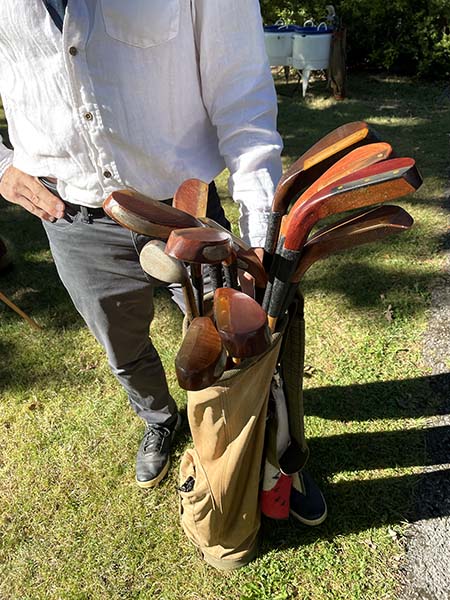
Most of the balls in play were made by McIntyre Golf Ball Co. whose owner, Dave Brown, turns out period specific balls for pre-1900 play. At Foxburg, those who wished a true gutty experience play McIntyre’s “Park” ball, made with a synthetic material surprisingly comparable to original gutta percha. Another division smote the “Braid” ball, slightly heavier but also a limited-flight edition. The rest of the field employed “modern hickory” or 1920’s era clubs and knocked about such pellets as Callaway Soft and what-not.
Golf events such as the FHS are generally, but not totally, characterized by older players. Among Foxburg’s 40 players were 20 for whom this was their first hickory golf event. One of these was Jacob Smith, 25, a budding professional golfer from Middleburg, Va., who attended the event with his girlfriend, Lilly Bonnie, a pre-school teacher. Smith, who earlier this year carded an ace (his first) on the Worthington Manor GC in Urbana, Md., during a U.S. Open Qualifier, said he was “blown away” by the experience at Foxburg.
“The people have unbelievable attitudes and spirit for the game of golf. There was so much love for this legendary U.S. golf course and the game of a previous age,” he said.
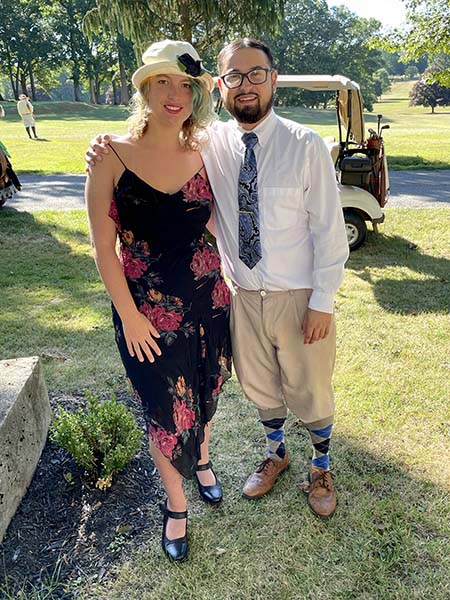
The two were captivated by the American Golf Museum in the Foxburg clubhouse, with its displays of ancient golfing memorabilia, photographs and books. “I learned so much about the game of golf just in this museum,” Smith said.
“Tom and Karen ran one of the smoothest golf events I’ve ever participated in, and I’ve been in more than 200,” he said. “I look forward to coming to many more events and networking with some wonderful human beings. Thank you for a memorable week.”
While our young golf professional was learning the rudiments of ancient golf weapons, Jason Kronenberger of Dayton, Ohio, the 2021 FHC champion played a beautiful, focused game to take the 2022 Open title as well, the FHC’s first repeat champion. Others have come close, Tom Johnson included, but only Kronenberger has accomplished the feat to date. He had some great competition, too. Bill Geisler of Winter Park, Fla., and James Kaiser of Louisville, Ky., were right on his heels but fell just a shot or two short.
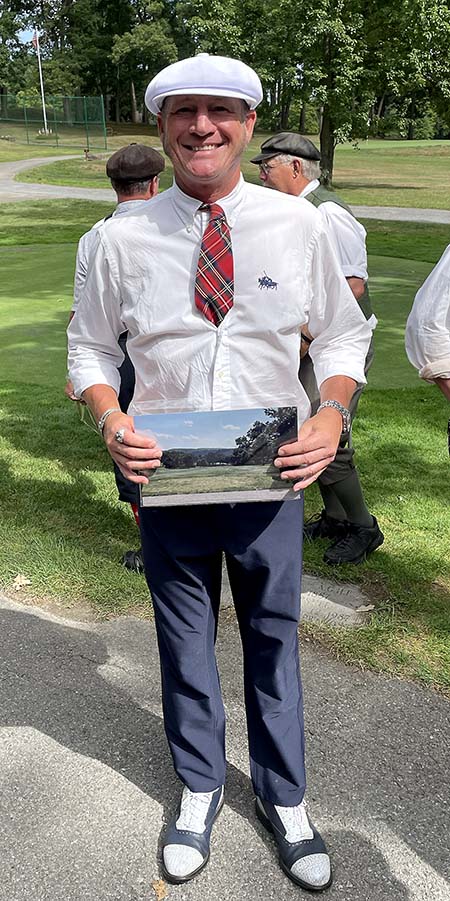
With the competition over, the players gathered round in front of the clubhouse and awards presented, Tom, in his closing remarks again marked by genuine emotion, thanked everyone for their participation, expressing heartfelt thanks that the event had generated $3,450, all toward the club’s operating expenses and a goodly bump in its yearly income.
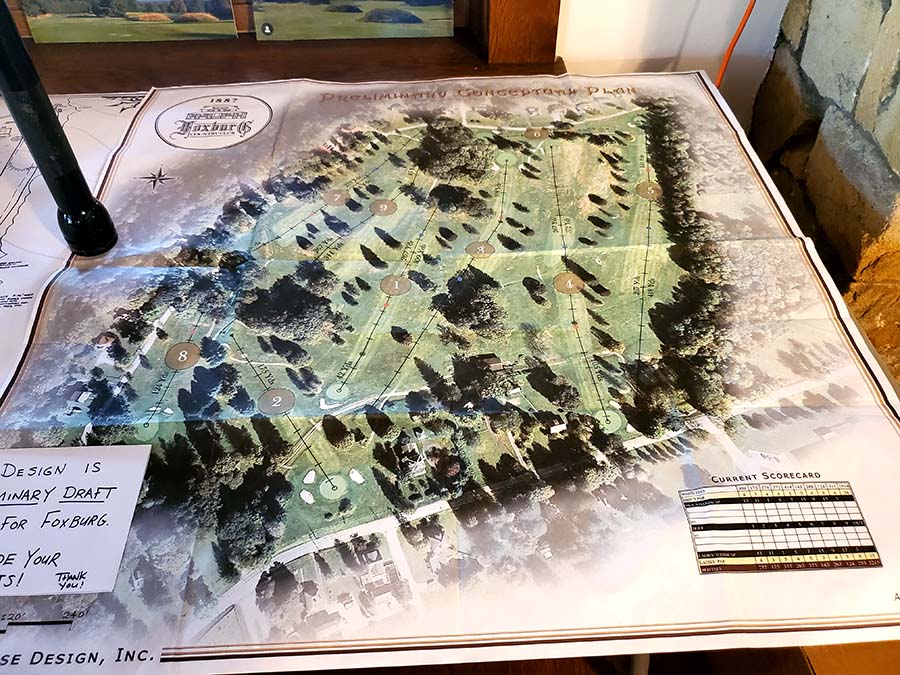
Foxburg’s future, too is the focus of The 1887 Project, a restoration and preservation effort to revitalize its design, and to support its infrastructure, personnel and equipment. A master plan is underway, led by Ron Forse of Forse Golf Design. Targeted are course restoration, an irrigation system, improved maintenance facility and turf equipment, and an endowment to support programming, equipment, technology and personnel. Visit www.1887project.org to learn more and make a donation.
The local newspaper had stopped by on the first day of golf to snap a few pictures, gather a few quotes and add further documentation of the beloved FCC’s relevance as a national treasure. (Click here to read the story.) Sports Editor John Enrietto of the Foxburg Butler Eagle seemed to be enjoying himself as he witnessed play around the 6th green (Putter’s Grief) and gathered quotes from several players. (Click here to see that story.)
One highlight he missed…
In the field was this humble correspondent whose presence escaped the notice of Mr. and Mrs. Johnson as they would have quickly acted to prevent any possibility of embarrassment to this important tournament. (Perhaps it was the assumed name used to gain entry to the field.) Be that as it may, well along on Ten Strike, good MacDuff’s ball came to nestle against the tall fescue on the left of the fairway. Unwilling to wade in amongst the tall weeds, and with some insolence, the man took his lofter, turned it upside down and made a mighty left-handed swipe at the, by-now, timid and fearful Braid golf ball. If flew happily away, straight and true, freed from the tyranny of the man’s hopeless right-handed swing, to land some 120 yards away, the green just a few steps beyond. One witness gleefully applauded the fearless play and astonishing result. MacDuff may have been seen to smile. As well he might. That stroke helped him card a smooth 100, well below his previous day’s efforts.
Gutty golf, says Mr. Tom Johnson, is the hardest golf you’ll ever play, but the most fun you’ll ever have.
Oh, how right he is.
